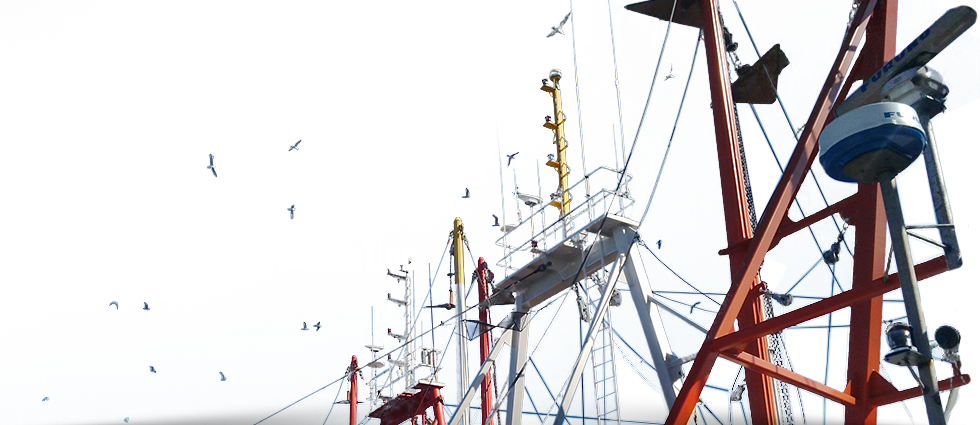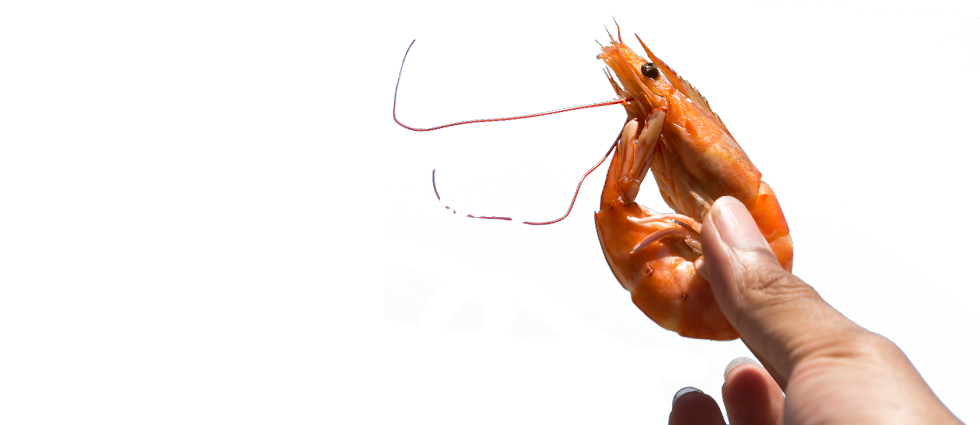Tag Archives: processing
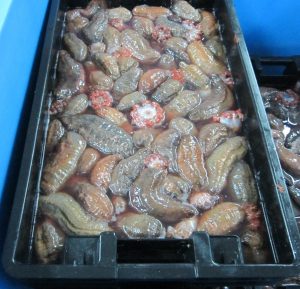 PROCESSING AND MARKET
The main market for sea cucumbers is processed products. A limited amount of raw sea cucumber is eaten worldwide.
In Asian markets, wild sea cucumbers are preferred over those produced from aquaculture, and sea cucumbers harvested from cold and arctic waters have a higher value over those from tropical and warm waters.
PROCESSING AND MARKET
The main market for sea cucumbers is processed products. A limited amount of raw sea cucumber is eaten worldwide.
In Asian markets, wild sea cucumbers are preferred over those produced from aquaculture, and sea cucumbers harvested from cold and arctic waters have a higher value over those from tropical and warm waters.
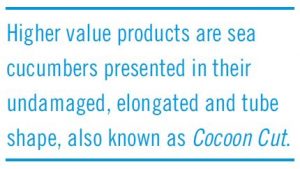 The processing of sea cucumbers depends on the market demand for the final product. Sea cucumbers are rich in protein and are used in traditional Chinese medicine. They are also a highly sought after food item. The most common product produced from sea cucumber is dried body walls, which is a traditional part of Chinese cuisine. The process consists on eviscerating and gutting the cucumber, then cleaning and cooking it in boiling water, and then drying it.
The longitudinal muscles (referred as meat) are also extracted from the sea cucumber and prepared for niche markets.
The sea cucumber’s head alone, also called flower, can also be dried as a lower end product.
The quality and value of sea cucumbers depend on the thickness of the body wall, skin coloration and texture. Higher value products are composed of sea cucumbers presented in their undamaged, elongated and tube shape, also known as Cocoon Cut.
The most commonly processed sea cucumber products are:
- Cocoon cut, skin with meat, dry or frozen.
- Butterfly cut, skin with meat, dry or frozen.
- Butterfly cut, skin without meat, dry or frozen.
- Sliced skin, frozen.
- Raw meat, frozen.
COCOON CUT versus BUTTERFLY CUT: PROCESS DESCRIPTION
The following compares the two most popular sea cucumber processing methods, Cocoon Cut and Butterfly Cut.
Butterfly Cut
The butterfly cut process consists on first cutting the sea cucumber along its body to gain access to the internal organs. Once that cut has been produced, the sea cucumber is “unrolled” which gives it a butterfly like shape. To “unroll” the cucumber, it is required to entirely or partially cut the head off and to partially cut of the anus off . Cutting or not the head entirely off is determined by the end product needed to be prepared (with or without head on). Once the sea cucumber has been flatten out, the internal organs are manually removed (gutting), most often with a scraping tool. This particular processing method also allows the possibility to detach the meat from the skin, to prepare the frozen raw meat and skin without meat products. The meat is detached manually with a scraping tool. Once the sea cucumber has been gutted, it can go through the remaining processing stages, cleaning, cooking, drying and freezing, all depending on the required end product to be prepared. It must be noted that some equipment available on the market have automated the cutting and gutting stages of the butterfly cut process.
Cocoon Cut
The cocoon cut is a much simpler process than the butterfly cut. It consist on cutting the head off to create an opening in which an especially designed cleaning tool is inserted to remove all the sea cucumber internal organs (gutting). The longitudinal cut - along the body - is not required. Cutting or not the head off is determined by the end product needed to be prepared (with or without head on). Once the sea cucumber has been gutted, it can go through the remaining processing stages, cleaning, cooking, drying and freezing, all depending on the required end product to be prepared. Oceatec’s cleaning line system is specially designed to produce the Cocoon Cut.
COCOON CUT versus BUTTERFLY CUT: COMPARATIVE ADVANTAGES
The processing of sea cucumbers depends on the market demand for the final product. Sea cucumbers are rich in protein and are used in traditional Chinese medicine. They are also a highly sought after food item. The most common product produced from sea cucumber is dried body walls, which is a traditional part of Chinese cuisine. The process consists on eviscerating and gutting the cucumber, then cleaning and cooking it in boiling water, and then drying it.
The longitudinal muscles (referred as meat) are also extracted from the sea cucumber and prepared for niche markets.
The sea cucumber’s head alone, also called flower, can also be dried as a lower end product.
The quality and value of sea cucumbers depend on the thickness of the body wall, skin coloration and texture. Higher value products are composed of sea cucumbers presented in their undamaged, elongated and tube shape, also known as Cocoon Cut.
The most commonly processed sea cucumber products are:
- Cocoon cut, skin with meat, dry or frozen.
- Butterfly cut, skin with meat, dry or frozen.
- Butterfly cut, skin without meat, dry or frozen.
- Sliced skin, frozen.
- Raw meat, frozen.
COCOON CUT versus BUTTERFLY CUT: PROCESS DESCRIPTION
The following compares the two most popular sea cucumber processing methods, Cocoon Cut and Butterfly Cut.
Butterfly Cut
The butterfly cut process consists on first cutting the sea cucumber along its body to gain access to the internal organs. Once that cut has been produced, the sea cucumber is “unrolled” which gives it a butterfly like shape. To “unroll” the cucumber, it is required to entirely or partially cut the head off and to partially cut of the anus off . Cutting or not the head entirely off is determined by the end product needed to be prepared (with or without head on). Once the sea cucumber has been flatten out, the internal organs are manually removed (gutting), most often with a scraping tool. This particular processing method also allows the possibility to detach the meat from the skin, to prepare the frozen raw meat and skin without meat products. The meat is detached manually with a scraping tool. Once the sea cucumber has been gutted, it can go through the remaining processing stages, cleaning, cooking, drying and freezing, all depending on the required end product to be prepared. It must be noted that some equipment available on the market have automated the cutting and gutting stages of the butterfly cut process.
Cocoon Cut
The cocoon cut is a much simpler process than the butterfly cut. It consist on cutting the head off to create an opening in which an especially designed cleaning tool is inserted to remove all the sea cucumber internal organs (gutting). The longitudinal cut - along the body - is not required. Cutting or not the head off is determined by the end product needed to be prepared (with or without head on). Once the sea cucumber has been gutted, it can go through the remaining processing stages, cleaning, cooking, drying and freezing, all depending on the required end product to be prepared. Oceatec’s cleaning line system is specially designed to produce the Cocoon Cut.
COCOON CUT versus BUTTERFLY CUT: COMPARATIVE ADVANTAGES
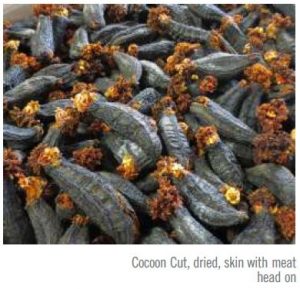 Advantages
Cocoon Cut
- Dry skin with meat product keeps its higher valued elongated and undamaged tubular shape. No longitudinal cut.
- Fewer processing steps for a cheaper processing cost and a faster process.
Butterfly Cut
- Possibility to produce the sea cucumber meat and skin without meat products.
Disadvantages
Cocoon Cut
- Entirely manual process is not possible, special cleaning tool is required.
- Detaching the meat from the skin is not possible while keeping intact the tubular shape.
Butterfly Cut
- The meat on skin product is damaged and does not retain the higher valued tubular shape.
- When fully manual, needs many required processing steps for a more expensive and elaborate process.
Advantages
Cocoon Cut
- Dry skin with meat product keeps its higher valued elongated and undamaged tubular shape. No longitudinal cut.
- Fewer processing steps for a cheaper processing cost and a faster process.
Butterfly Cut
- Possibility to produce the sea cucumber meat and skin without meat products.
Disadvantages
Cocoon Cut
- Entirely manual process is not possible, special cleaning tool is required.
- Detaching the meat from the skin is not possible while keeping intact the tubular shape.
Butterfly Cut
- The meat on skin product is damaged and does not retain the higher valued tubular shape.
- When fully manual, needs many required processing steps for a more expensive and elaborate process.
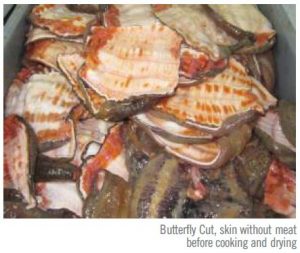 CONCLUSION
Due to the large variety of products that can be processed from the sea cucumber, setting up the right processing line can be confusing to processors. They simply must be aware and focus on the highest valued product that they can provide to their buyers on the long term.
They should also carefully analyse short term orders that might provide interesting commercial opportunities comparing to long term market trends that are pointing towards more added valued products, such as the Cocoon Cut sea cucumber.
This process selection also offers a tremendous opportunity to increase productivity and revenues while keeping the same number of workers and the same raw product supply. This is a strategic choice in these times of workers scarcity.
CONCLUSION
Due to the large variety of products that can be processed from the sea cucumber, setting up the right processing line can be confusing to processors. They simply must be aware and focus on the highest valued product that they can provide to their buyers on the long term.
They should also carefully analyse short term orders that might provide interesting commercial opportunities comparing to long term market trends that are pointing towards more added valued products, such as the Cocoon Cut sea cucumber.
This process selection also offers a tremendous opportunity to increase productivity and revenues while keeping the same number of workers and the same raw product supply. This is a strategic choice in these times of workers scarcity.
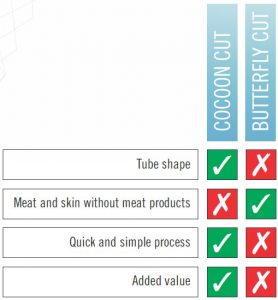 You can download this White Paper as a PDF file.
You can download this White Paper as a PDF file. This article is for the fish and seafood processing plant managers who aim at improving the productivity of their processing activity, and who want to make sure that their new processing equipment project will be a success.
These are the rules that should be followed for a successful seafood processing equipment project. These rules can apply to a process automation project, to a custom equipment design project, or to an equipment selection and implementation project.
1. Get out of the office
For the project manager of the firm or the vendor that you hire, a seafood processing equipment project shouldn't be completed from an office desk. The project manager should get out in the plant were the equipment will be used. He should see the facility, see how things gets done, how things moves around, from all aspect of the processing line, from start to finish. Ideally he should also be able to see how the processing stages are completed before and after the new processing equipment stages.
2. Get your hands dirty
When the project manager is in the plant, he shouldn’t look around from a distance. He should take the opportunity to dig his hands in the product. Literally. Get his hands dirty. He needs to have a good feeling of the product. Feel its texture, before and after it is processed. He needs to experiment the product if it is the first time he is working on that particular species. He should also be interested in everything that get thrown away in the process. Every member of his team, which will work closely on the project, should also have the opportunity to play with the product in their hands too.
3. Get it right
Every project starts with an idea from the management of the seafood processing operation. These guys know their business like no one by managing it on a daily basis. And they end up with a microscopic view of their seafood or fish processing activities. Take the opportunity of the seafood processing equipment project to take a telescopic view of the processing activities. Take a step back and look at a broader picture of all the performed activities. A good firm or vendor project manager has that distance. Often the solution identified in the first place is not exactly the one needed to solve the problem. And often, other more important issues will pop-up after a thorough analysis of the entire process.
4. Costs, costs and costs
Never keep your eyes off the costs. All the costs. Because costs are the main reason why a project fails. Not only the equipment cost, but also the costs required to complete the project and the costs that are involved in the equipment's life on the processing line (TCO - Total Cost of Ownership). The equipment project costs include the fees of the personnel responsible to complete the project, but also all the subcontractors fees. You should not forgot the equipment installation costs, transportation costs, customs and taxes costs. The costs related to the equipment usage include, among others, the energy costs, the maintenance costs, cleaning costs, waste water produced, and also the costs to manage the rejects produced by the equipment. The new equipment project shouldn’t be only a trilling mechanical design or automation project. The only goal of that project is to make your company more productive.
5. Prototype. Test. Repeat.
When the project involves experimental development or automation, quickly move on to testing. The project manager shouldn’t waist too much money on trying to design the perfect food processing engineering achievement right away. He should quickly build and test prototypes to validate the hypothesis and to solve the technical uncertainties with fresh seafood, crustacean or fish product. To save time in solving technological uncertainties, cheaper materials and manual actions should be used to simulate automated operation. By proceeding that way, uncertainties will be cleared faster and time and money will be saved on the project.

